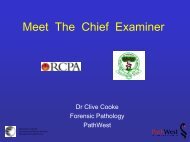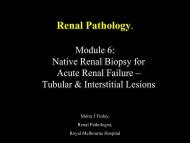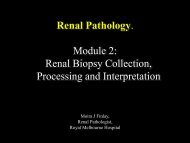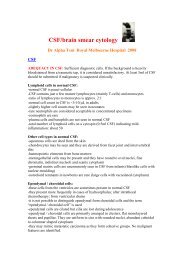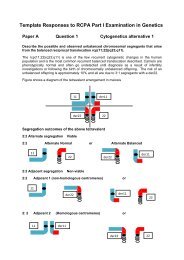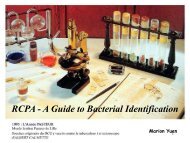Model Answers Microbiology Written examinations 2007 - RCPA
Model Answers Microbiology Written examinations 2007 - RCPA
Model Answers Microbiology Written examinations 2007 - RCPA
Create successful ePaper yourself
Turn your PDF publications into a flip-book with our unique Google optimized e-Paper software.
Question 4. Write short notes on:<br />
<br />
<br />
<br />
<br />
Norovirus detection<br />
Role of anaerobic blood cultures<br />
Flocked swabs<br />
Non cultivable bacteria<br />
Norovirus detection<br />
+ss RNA virus; Calciviridae, human calici virus distantly related to the other human<br />
calicivirus....sapovirus. 2 strains of Norovirus, genotype 1 and 2. Responsible for<br />
acute gastroenteritis. Nausea 9%, vomiting 69% and diarrhoea 66%, abdominal<br />
cramps 33% also headache, fever, chills reported. first recorded epidemic in 1968.<br />
Norwark virus. Epidemics occur in winter and spring and low background disease<br />
throughout the year. Often associated with hospitals, nursing homes, cruise ships,<br />
restaurant s and schools. Virus shed in vomitus and faeces. Faecal oral and vomitus<br />
oral eg alleged vomitus aerosol landing on food or fomites and then being consumed.<br />
In developed countries 50% population infected by 5 th decade. Acquired earlier in<br />
developing companies with poor sanitation. Gut virus receptor related to certain<br />
blood group antigens. Blood group B individuals are resistant to infection. RNA<br />
codes 3 ORF: ORF 1 encodes a non structural polyprotein that self cleaves to form 6<br />
structural proteins. ORF2 the capsid protein; ORF3 a minor structural protein.<br />
Diagnosis : RT-PCR of faeces or vomit. EM and IEM used in the past. Antigen<br />
based tests available but have low sensitivity and do not cover all human strains of<br />
norovirus probably due to antigenic variability/instability. (genotype 2 common<br />
strain in Australia<br />
Role of anaerobic blood cultures<br />
Past blood culture studies have shown rates of anaerobic bacteraemia of 10-15%.<br />
More recently this rate has fallen. ~5%. Finding anaerobes must be taken seriously<br />
as they can indicate important underlying primary infection or underlying disease. B<br />
frag = intraabdominal infection, F necrophorum + Lemmiere‟s disease or<br />
necrobacillosis with venoocclusive complications, clostridial sp and association with<br />
colonic cancer, gas gangrene. Often polymicrobial bacteria in gut disease.<br />
Automated systems detect anaerobes at similar rates<br />
Flocked swabs<br />
Used for 2 reasons; > nasopharyngeal cells cp cotton tipped swabs or NPAs, better<br />
detection of N gono and Chlamydia. Nylon, > absorbtive surface, non inhibitory<br />
Non cultivable bacteria<br />
Recent molecular tools suggest that non cultivable bacteria exist in many situations<br />
such as the gut. These organisms do not yet grow on defined media. An example is




